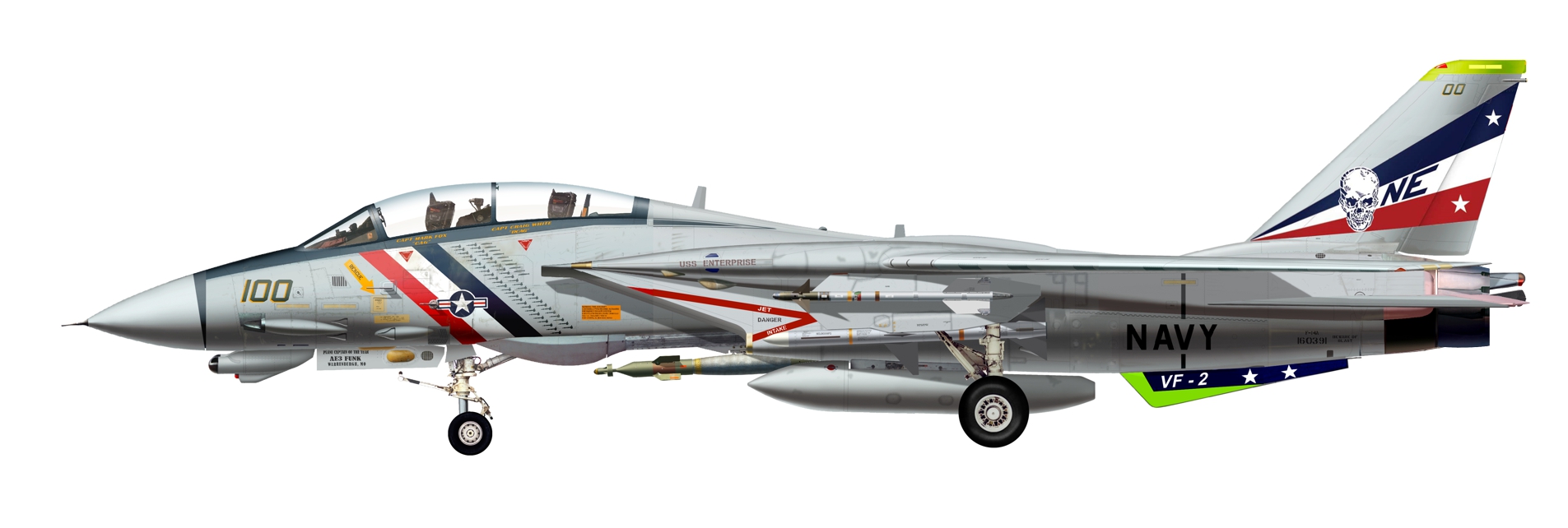
Grumman F-14 Tomcat ...............................................................Specifications

Grummann F-14D Tomcat number 100 of the Famous VF-2, based on the aircraft carrier USS Enterprise. This aircraft also saw action in the Gulf War
The Grumman F-14 Tomcat. No other aircraft represents more the armed might of the American armed forces. Visions of Tom Cruise in "Top Gun" come flooding back, just looking along the sleek powerful lines of this machine. Indeed a special brand of pilot is required to master such an aircraft, being grafted from other operational squadrons. Only the very best of the best !!
The Tomcat was envisaged as a Mcdonnell Douglas F-4 "Phantom" replacement for the US Navy, this aircraft being phased out by 1986; the prototype F-14 flew in 1970, the first examples going to VF-124 squadron in 1973. The Tomcat was one of two aircraft, the other being the McDonnell Douglas (now Boeing) F-15 Eagle, which were the last of a breed of "Big punch" fighters. The costs of development and manufacture being so astronomically high, the unit cost is about 38 million USD, that "cheaper" light weight aircraft like the F-18 Hornet or F-16 Fighting falcon were favoured, especially by air powers outside the U.S.A. Never the less the basic air frame, designed for a meager 6,000 to 7,000 hours will have served almost 40 years by the time the last models are retired from Navy service in 2010; not a bad run for the money invested. The only operator out side the US was the Imperial Iranian Air Force (I.I.A.F.) who recieved models in 1979 before the revolution. In 1989 there were still a few Iranian examples flying !!
The F-14 is designed as a carrierborne superiority fighter. It has a two seat, twin tail, variable-geometry wing lay -out and has all weather, night and day capabilities. It is capable of supersonic speed of over Mach 2. The Tomcat can track upto 24 targets simultaneously, can attack six of them and continue to scan air space for new targets, armament including 20 mm Vulcan Gatling type gun and air intercept missiles, rockets and bombs.
The swing wings are automatically swept during flight, although this program can be manuelly over riden, thus allowing low speed combat manoeuvres in the unswept state. At speeds above Mach 1, glove vanes in the leading edge of the fixed part of the wing are activated to shift the aerodynamic center of the aircraft forward, thus reducing the load on the tailplane.
The basic platform, incorperated the early Pratt & Whitney TF-30 engine, whose early teathing troubles were so bad that consideration was given to the development of a new engine all together. This would have been very costly and it was decided upon to make improvements to the engine instead, thus emerged the F-14A and all subsequent models were converted.
With the emergence of the General Electric F-110-GE-400 engine came the F-14B. The new engine offered a considerable increase in power as well as being much more reliable then the TF-30. On-board Navigation and Radar warning electronics were extensively modifyed. A few F-14A were modifyed to this standard as the F-14A+
The F-14D, the last upgrade in the program being delivered from 1990 onwards, has new radar and new avionics systems. Many new features which increase aircrew effectiveness through automation and simplicity were incorperated. Production effectively ended in 1991 after the cancellation of a big US Navy order, the result of Government cuts. Despite this JDAM, Joint Direct Attack Munitions have been operational since March 2003 on the F-14, this brings the Tomcats capabilities comfortably into the 21 century.
The Tomcat was retired from the U.S. Navy's active fleet on 22 September 2006. The Iranian Airforce is now (2016) the only air service world wide to fly the F-14.

The first Tomcats of 79 aircraft for the Imperial Iranian Air Force were delivered in 1976. These F-14A aircraft were the only Tomcats to be delivered outside of the USA and since 2006, after the retirement of F-14s in USAF and US Navy services, the only Tomcats in service with armed forces world wide ! This aircraft participated in the Iran - Iraq war from 22 September 1980 to August 1988. Note the obvious differences to the above pictured F-14D; a Pratt & Whitney TF30-P-414A which was replaced in the B and D models with a General Electric F110 - 400. Also the under nose fairing of the B and D models was larger, housing a different video monitering TV camera.
